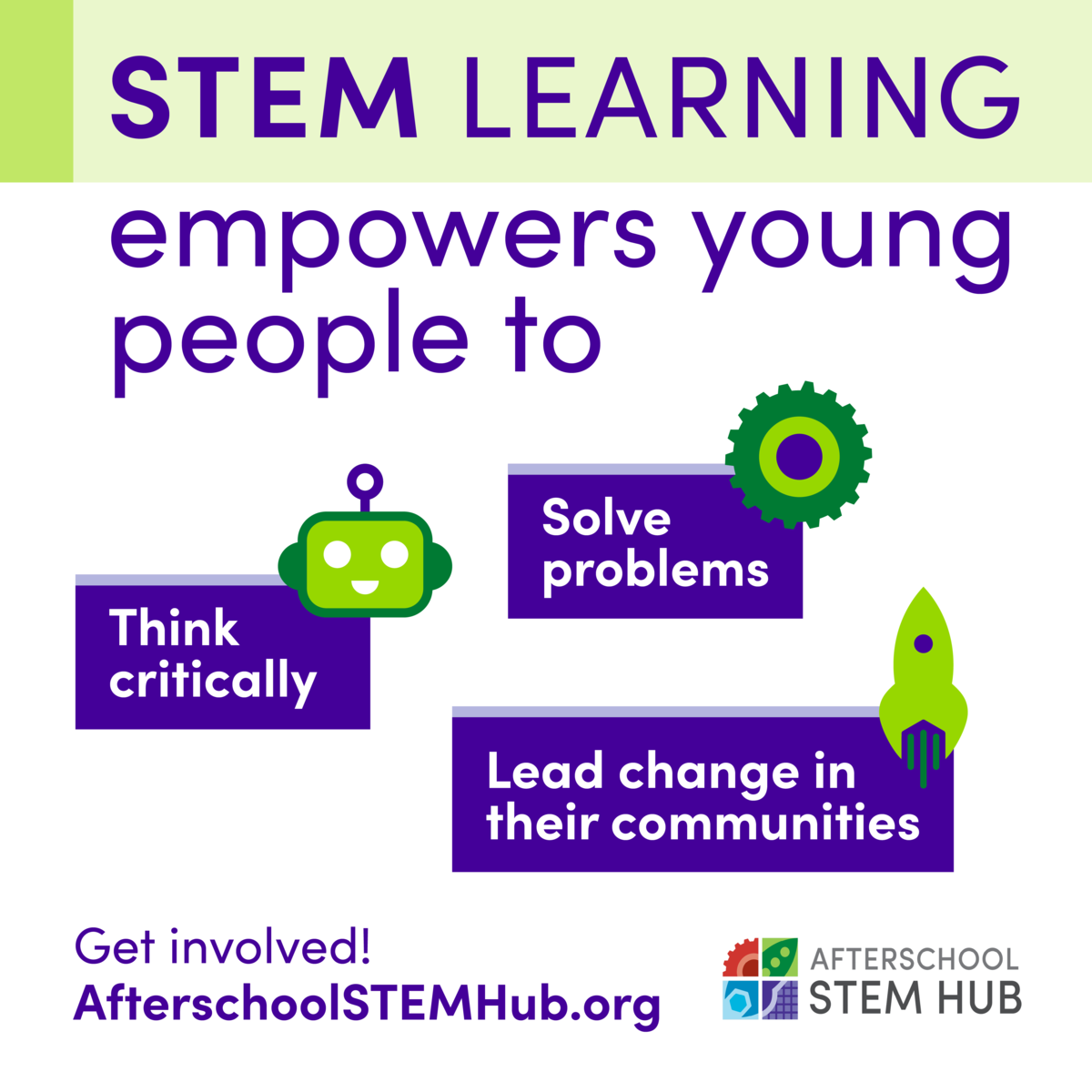Afterschool programs have become essential partners in STEM education, offering engaging STEM enrichment experiences that support and enhance what is learned during the school day. Research shows that high-quality, expanded STEM learning opportunities can improve academic outcomes, increase college and career readiness, and foster positive youth development.
Not only are STEM jobs projected to grow faster than jobs in other areas, but every community also needs STEM-literate citizens who can engage with and help solve critical issues that impact our society. While the economy is still one of the top priorities for most Americans, the majority are more concerned about social issues. And as it turns out, today’s youth are committed to and motivated by contributing to improvements in society and their communities. Afterschool STEM programs offer many youth an entry point for engaging with STEM as a means to solve societal issues, which further sustains youths’ interests in pursuing STEM careers or using STEM for civic engagement.
Moreover, a recent World Economic Forum report reveals that, ahead of technological literacy, the top five skills identified as being in high demand within organizations are:
Afterschool STEM programs are uniquely situated to help youth build these critical skills in tandem with the technical STEM skills.
Afterschool STEM programs are not a luxury but a necessity. By supporting afterschool STEM programs, we can ensure that all students have access to high-quality STEM education and opportunities to help them and our communities thrive in the 21st century.
For more resources to make the case for afterschool STEM, visit the Afterschool STEM Hub and the Collective for Youth Empowerment in STEM & Society, where afterschool STEM advocates can check out the talking points, find infographics, fact sheets, and more.

STEM literacy skills are needed now. Afterschool STEM opportunities spark STEM learning and prepare our nation’s youth.
Since students spend more than 80 percent of their waking hours outside of a formal classroom, afterschool, summer, and other out-of-school time programs are crucial partners in STEM education.
Just like learning a new language, young people must be immersed in STEM to become fluent. Quality afterschool STEM programs provide the opportunity for youth-led experimentation, investigation, and analysis, without fear of failure. In addition to teaching STEM skills, these kinds of actvities build teamwork, colaboration, and communications skills and help youth connect STEM to things that matter to them -- even using STEM tools to solve problems in their communities.
The current system of afterschool STEM opportunities is patchy. Some students are in places with lots of access to STEM learning opportunities, but others are in STEM learning dead zones. Afterschool programs can help connect students – whether in urban, suburban, or rural communities – to powerful STEM learning opportunities. By investing in and partnering with afterschool programs, we can build a robust STEM learning environment in every community that will expand access for all young people.
Afterschool STEM learning opportunities play a proven role in helping kids gain STEM interests and skills. Talking about afterschool in the context of STEM is a great way to link afterschool to a number of important issues that voters, candidates and policy makers care about. Below are suggested talking points to share with candidates to help them make the connection between afterschool and STEM.
Parents across the U.S. are increasingly wanting these opportunities available for their children. The need for a diverse array of STEM skills and knowledge is more important than ever. Supporting and increasing investments in afterschool, summer, and other out-of-school time STEM is an effective way to reach a multitude of young people who would otherwise be left out.
Clemson University Science Outreach Center
In partnership with Urban League of the Upstate and the Concerned Citizens of Tillery, Clemson University’s Science Outreach Center is working with middle-school youth in co-developing a graphic novel and afterschool STEM curriculum called My STEM My Story. The goal is to instill confidence in young people to use STEM for good in their communities and reconnect a sense of trust in scientists.
California Academy of Sciences Science Action Club
A program within the California Academy of Sciences, Science Action Club (SAC) enrolls out-of-school time educators in their community science curriculum and training to lead the field in imagining more sustainable, engaging, and impactful STEM programs for youth and training for staff. Since 2011, SAC has engaged over 98,000 youth and educators across 480 communities in 42 states and three countries.